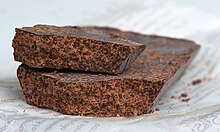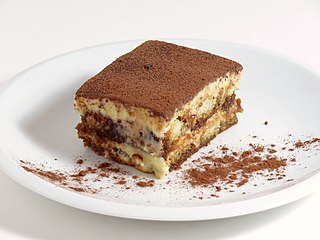
Tiramisu is an Italian dessert made of ladyfinger pastries (savoiardi) dipped in coffee, layered with a whipped mixture of eggs, sugar and mascarpone and flavoured with cocoa. The recipe has been adapted into many varieties of cakes and other desserts. Its origin is disputed between the Italian regions of Veneto and Friuli-Venezia Giulia. The name comes from the Italian tirami su.
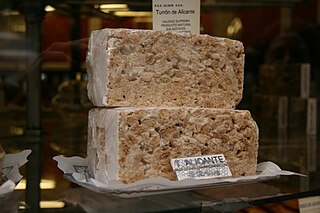
Turrón, torró or torrone is a southwest European and Moroccan nougat confection, typically made of honey, sugar, and egg white, with toasted almonds or other nuts, and usually shaped either into a rectangular tablet or a round cake. Turrón is usually eaten as a dessert food around Christmas in Spain and Italy. It is also popular in Portugal, Morocco, and Latin America.

Fettuccine Alfredo is a pasta dish made with fettuccine, butter, and Parmesan cheese. As the cheese is mixed with freshly cooked, warm fettuccine and ample butter, it melts and emulsifies to form a smooth, rich cheese sauce coating the noodles. Originated in Rome in the early 20th century, it is now popular in the United States and other countries. Cream is commonly added to American versions, which are often served as a main course with optional chicken, shrimp, salmon or other ingredients on top or on the side.
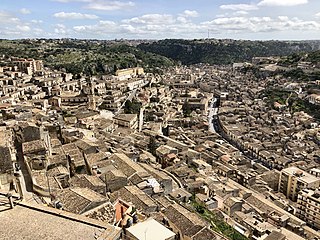
Modica is a city and comune of 54,456 inhabitants in the Province of Ragusa, Sicily, southern Italy. The city is situated in the Hyblaean Mountains.

Palma di Montechiaro is a town and comune in the province of Agrigento, Sicily, southern Italy. Many Greek archaeological findings of Magna Graecia have been found near the town.

Venchi is an Italian gourmet chocolate manufacturer founded by chocolatier Silviano Venchi. After its establishment in Turin in early 1878, the company expanded throughout Italy with its Nougatine, small candies made of crushed and caramelized hazelnuts coated in dark chocolate.

Swiss chocolate is chocolate produced in Switzerland. While cacao beans and other ingredients, such as sugar cane, originate from outside Switzerland, the actual production of the chocolate must take place in Switzerland. Switzerland's chocolates have earned an international reputation for high quality with many famous international chocolate brands.

An affogato, known in full in Italian as (gelato) affogato al caffè, is an Italian coffee-based dessert. It usually takes the form of a scoop of plain milk-flavored or vanilla gelato or ice cream topped or "drowned" with a shot of hot espresso. Some variations add a shot of amaretto, bicerin, Kahlúa, or other liqueur.

Chocolate salami is an Italian and Portuguese dessert made from cocoa, broken biscuits, butter and sometimes alcohol such as port wine or rum. The dessert became popular across Europe and elsewhere, often losing alcohol as an ingredient along the way.

Caffarel is a chocolate-manufacturing company based in Luserna San Giovanni, Italy, which is a subsidiary of Lindt & Sprüngli. The company was founded in Turin during the 19th century. According to the company, it was founded in 1826 when Pierre Paul Caffarel (1801–1871) converted an ex-tannery into a chocolate factory and invented Gianduiotto in 1852.
Force of the South was a liberal-conservative political party in Italy based in Sicily.

Massimo Bottura is an Italian restaurateur and the chef patron of Osteria Francescana, a three-Michelin-star restaurant based in Modena, Italy. It has been ranked No.1 on The World's 50 Best Restaurants list twice and is currently part of the Best of the Best list.
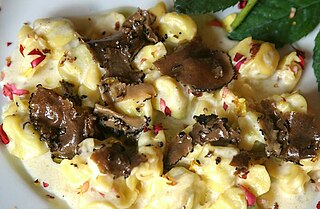
Fagottini is a kind of filled pasta. It is usually filled with vegetables, typically steamed carrots and green beans, ricotta, onion and olive oil. Fagottini are made by cutting sheets of pasta dough into squares, placing the filling on the square, and folding the corners to meet in a point.
Torta setteveli is a seven-layer cake. Traditionally served at birthdays, it includes chocolate and hazelnuts.
The Antica Dolceria Bonajuto is a chocolate factory founded in Modica in 1880, known to be the oldest in Sicily and one of the oldest in Italy and for having been frequented by illustrious people of international fame.

Sellerio Editore is an Italian publisher founded in 1969 in Palermo, by Elvira Giorgianni and her husband Enzo Sellerio, encouraged by the writer Leonardo Sciascia and the anthropologist Antonino Buttitta.

Alprose is a Swiss chocolate producer based in Caslano (Ticino). It was founded in 1957 under the name Titlis SA and received its current name in 1983.

The Fabbrica di Cioccolato Cima Norma S.A., also Chocolat Cima-Norma S.A., in Torre-Dangio was an industrial chocolate production company in the canton of Ticino. It was founded in 1903 by the Cima brothers. It went bankrupt in 1968. The company Cima Norma S.A. also stands for the economic development and modernization advancement goal from the beginning of the 20th century for the mountain valley Blenio Valley, which was classified as a peripheral region.

The Siracusa–Gela–Canicattì railway is a single-track line in Sicily, Italy managed by RFI. The route connects Syracuse on the Ionian side of Sicily to the Mediterranean side, crossing, with an east-west route, a number of large urban centers to Canicattì.
